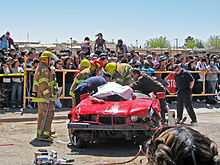Every 15 Minutes

Every 15 Minutes is a two-day program focusing on high school juniors and seniors, which challenges them to think about drinking, driving, personal safety, and the responsibility of making mature decisions. Along with alcohol-related crashes, it focuses on the impact that their decisions would have on family and friends.
The Every 15 Minutes program originated in Canada and was soon adopted in the United States first in Spokane, Washington.[1] The site of the first Every 15 Minutes program in California was in Chico which was presented by the Chico Police Department in 1995.[2]
Planning and events
Planning
The Every 15 Minutes program starts months in advance of the actual presentation, in fact the very first program at a school will take about one-year to plan and prepare. This includes all of the involved agencies, the hospital, court, lawyers, judge, coroner/funeral home, students, parents and school administrators. Student participants are selected to cover the full spectrum of the student body, thus, the audience will be able to relate to at least one of the participants on the crash day.
Recent advances
Due in large part to major grants and guidance by the Highway Patrol, the program has made its way to even more students' hometowns. In recent years, the California Highway Patrol has continued to fine-tune the Every 15 Minutes program, which has always been over two-days - day one being the crash, with day two as the assembly, featuring speakers ranging from the student participants and their parents to motivational speakers, relatives who have lost loved ones in drunk-driving crashes (there are no drunk-driving "accidents"), medical personnel, lawyers and law enforcement officials.
In southern California the program has also been modified by a civilian coordinator who has taken the audience away from watching on the sidewalk to sitting in bleachers, allowing for better viewing; eliminating the grim reaper (often viewed by students as unreal); and adding a texting element to the sober driver. This element brings the program added reality, as current figures indicate more teens are being killed in text-related crashes than in drunk-driving crashes. However, the grants are dedicated to drunk-driving and would be eliminated if too much emphasis was placed on texting. To still maintain the drinking emphasis, it is mentioned that the sober driver could have lessened the severity of injuries or death had they been concentrating on the road and not on the phone.
Since its inception, technology has improved, giving a rise to the impact of the program and the gravity of the issue of drunk driving. During the event, new technology has allowed for a quick turn around of videography, allowing a comprehensive video of the cause and effect relationship between drunken driving and police involvement, family burden and community loss to be played at the second day's assembly. While student videographers sometimes take on this job, it is more common for professional crews to do the work.[3] More recently, there has been a revival of student work, as schools either ask for one or two of their students to apprentice with the professionals, or students create a "making-of" film, shadowing the entire E15 process.
Recently the program has been extened. Kids are made to play the actual roles within the accident, especially in California. Cars are crashed, students bloody and handcuffed, and parents are told their children have been killed. Some protest this, saying it is traumatizing.
Effectiveness
Studies that have tracked students before and after the Every 15 Minutes program have shown that the program may have a favorable short-term effect on students' stated attitudes but no effect on actual behavior.[4] This has led to charges that the Every 15 Minutes program is similar to the controversial DARE anti-drug program in that it produces the appearance of addressing the problem but does not produce the desired change in behavior.
Questions have also been raised about the basic premise of the program, that one person dies every 15 minutes in an alcohol-related crash. The National Highway Traffic Safety Administration reports that in 1995, the first year the program was presented, the rate was actually one death every 30.4 minutes in the United States. This was using the NHTSA's very broad definition of "alcohol-related" wherein the crash was defined as "alcohol-related" if any person involved had a blood alcohol level of 0.01% or higher. The nationally recognized DUI level of presumption in the United States is 0.08%. The rate of alcohol-related fatalities has gradually declined and at the end of 2007 was one death every 40.4 minutes.[5] The rate of alcohol-related fatalities at the end of 2008 was one death every 45 minutes.[6]
References
- ↑ "Every 15 Minutes". Santa Rosa Police Department. Retrieved 28 April 2015.
- ↑ "Fact Sheet: Every 15 Minutes" (PDF). California Highway Patrol. Retrieved 28 April 2015.
- ↑ "Every 15 Minutes at Germantown High School". Wisconsin Public Safety Photo Library. Retrieved 30 April 2015.
- ↑ "Measuring the effectiveness of a community-sponsored DWI intervention for teens" (PDF). oregonstate.edu. Retrieved 28 April 2015.
- ↑ "2007 Traffic Safety Annual Assessment" (PDF). National Highway Traffic Safety Administration. Retrieved 30 April 2015.
- ↑ "2008 Traffic Safety Annual Assessment" (PDF). National Highway Traffic Safety Administration. Retrieved 30 April 2015.
External links
| Wikimedia Commons has media related to Every 15 Minutes. |
Photos
- Every 15 Minutes at Germantown High School
- Every 15 Minutes at Menomonee Falls High School
- Every 15 Minutes at West Bend East & West High Schools